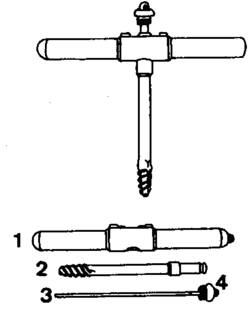Diameter increment
| Line 1: | Line 1: | ||
| − | {{ | + | {{Fmcontent}} |
| − | + | ||
[[File:2.6.4-fig25.png|left|250px|thumb|'''Figure 2''' Increment borer (Kleinn 2007<ref name="kleinn2007">Kleinn, C. 2007. Lecture Notes for the Teaching Module Forest Inventory. Department of Forest Inventory and Remote Sensing. Faculty of Forest Science and Forest Ecology, Georg-August-Universität Göttingen. 164 S.</ref>).]] | [[File:2.6.4-fig25.png|left|250px|thumb|'''Figure 2''' Increment borer (Kleinn 2007<ref name="kleinn2007">Kleinn, C. 2007. Lecture Notes for the Teaching Module Forest Inventory. Department of Forest Inventory and Remote Sensing. Faculty of Forest Science and Forest Ecology, Georg-August-Universität Göttingen. 164 S.</ref>).]] | ||
| Line 8: | Line 7: | ||
For example, increment in diameter of a single tree is usually calculated by the measured diameter at the beginning and at the end of a given period: | For example, increment in diameter of a single tree is usually calculated by the measured diameter at the beginning and at the end of a given period: | ||
| − | :<math>\Delta{d}=d_2-d_1\,</math> | + | :<math>\Delta{d}=d_2-d_1\,</math> |
Likewise, for other variables computation of growth attribute can be done by successive measurements. | Likewise, for other variables computation of growth attribute can be done by successive measurements. | ||
Revision as of 14:08, 26 October 2013

Forest growth may be part of an inventory. Growth is increase in size of the tree over time, and increment is the increase in size, which occurs in a specified time interval due to growth and refers to diameter, basal area, height, volume and biomass. In order to quantify (and possibly model) growth and increment of trees and forest stands, the tree attributes need to be measured in time intervals. The difference between the measurements is then taken as increment. The two conventional expressions of volume increment are current annual increment (CAI) and mean annual increment (MAI) where usually a time period is given which explains to which time period the mean refers. Diameter increment is an attribute that is used for growth modeling, which is important in developing a sustainable harvesting plan. Diameter increment shows the growth rate of a tree and can thus be used in planning the harvesting rotation year.
For example, increment in diameter of a single tree is usually calculated by the measured diameter at the beginning and at the end of a given period:
\[\Delta{d}=d_2-d_1\,\]
Likewise, for other variables computation of growth attribute can be done by successive measurements. Measurement of diameter increment can be done using an increment borer (Figure 1); with this borer a hole of defined depth is drilled perpendicularly through the bark into the stem always trying to aim at the center of that tree. Then a borer core can be taken out of the tree on which year rings can be counted and measured; that is, this technique is only working if the tree species of interest is developing visible year rings. Then also tree age can be estimated.
The increment borer is a nondestructive instrument in principle, although some damage is done to the tree which may cause fungi to intrude and to cause major damage. Depending on species, some species are really hard to be bored due to its high wood density and the small round sharpened “tongue” of the device, which cuts out the borer core breaks easily when the instrument is not being properly used.
References
- ↑ Kleinn, C. 2007. Lecture Notes for the Teaching Module Forest Inventory. Department of Forest Inventory and Remote Sensing. Faculty of Forest Science and Forest Ecology, Georg-August-Universität Göttingen. 164 S.